Review for Star Trek - Deep Space Nine - Series 1 (Slimline Edition)
Introduction
In all likelihood Star Trek Deep Space Nine will never come out on Blu-ray. It looked like a different proposition 18 months ago. The original Star Trek came out on Blu-ray and sold big, quite naturally the movies came out in HD as well, and Enterprise was a native HD show, Blu-rays were expected. The big deal was The Next Generation. Like most of 80s and 90s US television, The Next Generation was shot on film, it was merely edited, the special effects shots completed on videotape, all useful for distribution to network affiliates. The DVDs that came out were mastered from those tapes, so The Next Generation never looked as good as it could have, and the same was true for Deep Space Nine and Voyager as well. Paramount and CBS went back, and put the money into rebuilding the Next Generation, going back to the original film negatives, recreating the effects shots, effectively re-editing the show from scratch, identically to the original broadcast, but for HD distribution, and so The Next Generation came out on Blu-ray.
And apparently it has flopped, or at least flopped to the degree that it’s just about breaking even. For one thing, we were back to the plastic DVD boxset era when it came to the pricing, £70 for a season. For another, Paramount just released them without any fanfare, expecting the fans to lap them up out of sheer fervent inertia. Do you remember any adverts for the Blu-rays? It apparently took about $9 million to recreate TNG for HD standards. Deep Space Nine has around ten times the special effects shots, the latter half of the series is pretty much all CGI, those models were rendered for 480i, and most of them have been lost as effects houses have cleared out hard drives and upgraded computers. Deep Space Nine needs a lot more money to be made HD ready, and for a significantly smaller (if more vocal) fan base. And in an age where it seems the big studios are giving up on permanent media in favour of online streaming (Fox has just cancelled The Simpsons DVD releases), I can’t envisage ever owning DS9 in HD quality.
Which is why I’ve finally given in and started buying the show on DVD. For one thing it’s cheap, and the second thing, having seen the benefits of upgrading the original series to disc and freeing up over a metre of shelf-space, with Deep Space Nine, I’ll be able to get another three metres! Incidentally I spent close to four figures collecting those tapes, some gorgeous artwork on the sleeves. I had a look on e-bay, and it’s depressing. Carpets and carpets covered in videotapes, priced at a pound the lot, or collection only... all gaining zero bids. I guess the bin beckons for my collection, although I’ll keep the sleeve art.
At the edge of the final frontier there’s... politics. The planet Bajor has finally been returned to its population after decades of occupation, oppression, and exploitation by the Cardassian Empire. The wrecked world needs help getting back on its feet, and the provisional government has called in the Federation and Starfleet to administer the space station the Cardassians left behind, now dubbed Deep Space Nine, in the hope that it will become a hub for trade and commerce in the sector. To that end, and to move the Bajorans toward eventual Federation membership, Commander Benjamin Sisko has been assigned to DS9, although he only reluctantly accepts the posting. And not all of the Bajorans want the Federation there, certainly not the Bajoran liaison, his second in command, Major Kira Nerys. But when they discover a wormhole in the nearby Denorius Belt, the first known stable wormhole in existence, offering a shortcut to the Gamma Quadrant, Bajor suddenly becomes the centre of galactic attention, and that might be just the excuse the Cardassians need to move back in.
19 episodes of Season 1 of Star Trek: Deep Space Nine are presented across 6 discs with extras, from Paramount Home Entertainment.
Disc 1
1. The Emissary
The Battle of Wolf 359 took place three years previously when the Borg attacked the Federation. 40 starships were lost, including the Saratoga. Its first officer, Benjamin Sisko survived, along with his son Jake, but he lost his wife Jennifer in the attack. Following the battle, he took a ground assignment to try and give his son some stability, but he’s now been ordered to take command of Deep Space Nine, a space station orbiting Bajor, a world recovering from decades of occupation. His second in command is equally reluctant to see Starfleet there, a former Bajoran resistance fighter, Major Kira Nerys. Security on the station is handled by a shapeshifter of unknown origin, Constable Odo. Joining Sisko as part of the Starfleet contingent as Chief of Operations, transferring over from the Enterprise with his family, is Miles O’Brien. There’s also Sisko’s old friend, and now science officer, the joined Trill Jadzia Dax, and the newly minted doctor, Julian Bashir. All Sisko wants to do is leave with his son, but when the spiritual leader of Bajor, Kai Opaka reveals one of the Orbs of the Prophets to him, and tells him that his destiny is to find the Celestial Temple, Ben Sisko’s fate is irrevocably altered.
2. Past Prologue
While Bashir is getting friendly with the neighbourhood Cardassian spy Garak, a Bajoran terrorist fleeing from the Cardassians seeks asylum on the station. Tahna Los says that he wants to leave the Kohn-ma, and old friend Major Kira believes that a free Bajor needs him for its strength. But Tahna is critical of Kira working with the Federation, and he isn’t telling the whole truth about his request for asylum. Meanwhile, the notorious Klingon sisters L’Ursa and B’Etor pay a visit to the station.
3. A Man Alone
Relationship troubles on Deep Space Nine already. Bashir’s putting the moves on Dax, while Sisko’s having trouble getting used to his old friend in a young woman’s body. The O’Briens are rowing, with Keiko feeling useless in the middle of nowhere. Jake’s made a new friend in the Ferengi boy Nog, and both are getting into mischief, and Odo’s needling the owner of the station bar, Nog’s uncle Quark. Then into Quark’s walks Ibudan, black market racketeer and criminal, and Odo’s long time bugbear. But when Ibudan turns up dead, the chief of security becomes the prime suspect in his murder.
Disc 2
4. Babel
With the maintenance problems prevalent on the station, Chief of Operations Miles O’Brien is wholly snowed under. Repairing a malfunctioning replicator triggers a long-hidden piece of sabotage, releasing a perfidious virus into the food. With Quark eager to use the one working replicator on the station to supply his bar, it isn’t long before people all over the station are infected, and with as the first symptom is losing the ability to communicate, it makes it even harder for Dr Bashir to seek a cure.
5. Captive Pursuit
The first visitor from the Gamma Quadrant turns out to be an enigmatic, tight-lipped alien named Tosk, who arrives in a damaged ship. O’Brien manages to befriend him as he repairs the ship, but Tosk remains reticent about just why he’s there. When another ship from the Gamma Quadrant arrives, its crew looking for Tosk, O’Brien’s faced with a choice, between his oath to Starfleet and his new friend.
6. Q-Less
A runabout returns from the Gamma Quadrant, its power dangerously low but carrying a passenger, the archaeologist Vash. Following her last adventure in Sherwood Forest with the crew of the Enterprise, she’s been lost in the Gamma Quadrant, but has managed to obtain several valuable alien artefacts. Quark offers to help her auction them, for a cut, but it isn’t long before the station begins to suffer inexplicable power drains. And then Q arrives.
7. Dax
The Trill lifecycle is complex, with a worm like symbiont passing from one host to the next, retaining memories of previous joinings, and passing that life experience to the new host. Jadzia is Dax’s new host, following the death of the previous host and Sisko’s mentor, Curzon. But now someone comes to Deep Space Nine looking to extradite Dax for the crimes of treason and murder, crimes that Curzon is accused of, but for which Jadzia will be punished.
Disc 3
8. The Passenger
When a runabout comes to the aid of a Kobliat vessel in distress, Dr Bashir is almost throttled for his troubles by a dying prisoner. Fortunately, the security officer in charge of his transfer is a little more thankful for their aid, although she’s paranoid about ensuring that the prisoner actually died. And with good reason, for there’s a shipment of a precious commodity due at the station, and there will be a hand reaching from beyond the grave to steal it...
9. Move Along Home
A new species arriving from the Gamma Quadrant means a new opportunity for a first contact, and diplomatic relations. But the frivolous Wadi are only interested in games, and the first place they head is Quark’s. Sisko decides to take a break from the ‘negotiations’ while the Wadi get their gaming out of their systems, but when Quark tries cheating them, the Wadi decide to play their own game, with Sisko, Bashir, Kira and Dax as the stakes.
10. The Nagus
When the Ferengi leader, the Grand Nagus arrives on Deep Space Nine, Quark fears for his livelihood, sure that his bar will be bought out from under him. But the epitome of all greed has other plans for Quark. The wily barkeep is to be the next Grand Nagus, a decision that has the other Ferengi up in arms. Meanwhile Commander Sisko is concerned with how much time his son spends with Nog.
11. Vortex
They have another visitor from the Gamma Quadrant, but Kroden is more intent on keeping a low profile than opening diplomatic relations. That raises the suspicions of Odo, suspicions warranted when Kroden kills a Miradorn in a petty robbery gone wrong. But Kroden recognises Odo for what he is, a Changeling, and suggests that there are more just like him in the Gamma Quadrant. But there will be a price for this tantalising information.
Disc 4
12. Battle Lines
Kai Opaka, the spiritual leader of Bajor pays a visit to the station to get a closer look at the Celestial Temple of the Prophets, the wormhole. Sisko offers her a trip through in a runabout, but it’s an ill-fated offer. In the Gamma Quadrant, curiosity draws them to a desolate moon, where the runabout crashes, killing the Kai. The survivors find that they’re on a penal colony, where two groups have been left to fight an eternal war, a war where the dead don’t stay dead.
13. The Storyteller
Que Sirah! Sirah! While Sisko mediates between two rival Bajoran factions disputing ownership of a piece of land, with one of the leaders a young girl catching the eyes of Jake and Nog, Bashir and O’Brien head to Bajor to respond to a medical emergency, only for O’Brien to be thrust into the role of the village spiritual leader, expected to save the village from an energy beast!
14. Progress
In a major step towards reconstruction, one of Bajor’s moons will become a significant energy source for the planet. It falls to Major Kira to ensure that the inhabitants of the moon have been relocated, but one cantankerous farmer named Mullibok refuses to leave his home. As Kira gets to know him, she finds her instincts coming into conflict with her duties.
15. If Wishes Were Horses
Odo’s expounding on Quark’s holosuites, and the imaginative programs that his clientele use, thankful that he doesn’t have an imagination. But imagination is about to run riot on the station. O’Brien’s bedtime story to his daughter Molly, Rumplestiltskin has come to life. Legendary baseball player Buck Bokai has just walked off the holosuite after Jake Sisko, and Julian Bashir finds that the object of his desire, Jadzia Dax is suddenly feeling uncharacteristically affectionate. Then it starts snowing on the promenade.
Disc 5
16. The Forsaken
Federation Ambassadors are visiting the station, and it’s fallen to Sisko’s most junior officer, Dr Bashir, to run interference. Bashir’s got his hands full, but it could have been a lot worse, as Betazed’s Lwaxana Troi has devoted her attentions to Constable Odo, after he retrieved a stolen brooch. But then a playful AI arrives from the Gamma Quadrant, wreaking havoc on the station, and trapping Odo and Lwaxana in a turbolift.
17. Dramatis Personae
The usual friction is in evidence as Sisko and Kira disagree over the docking rights of a Valarian freighter, but things are about to take a wholly unusual tack, when a Klingon ship returns from the Gamma Quadrant, only to explode, with a single, short-lived survivor beaming to the station, only to expire with the word ‘Victory’ on his dying breath. Suddenly the station’s command staff is behaving very oddly indeed, split down the middle, seeing conspiracies around every corner, and actively plotting against each other.
18. Duet
When a freighter arrives with a passenger suffering from the rare Kalla-Nohra syndrome, a conscientious Kira Nerys expects to be dealing with a Bajoran survivor of the Gallitep labour camp. But the passenger is Cardassian, which in Kira’s eyes makes him a war criminal implicated in a horrific atrocity against the Bajoran people. Aamin Marritza claims he was merely a filing clerk at the camp, but the reality is far more complicated than that.
19. In the Hands of the Prophets
There was bound to be friction when the secularist Federation started working with the spiritual Bajorans. The surprise is that it took so long. The flashpoint is Keiko O’Brien’s school, when she starts teaching the Bajoran children about the wormhole and the aliens within, instead of the Celestial Temple and the Prophets. The leader of an obscure religious sect, Vedek Winn shows up on the station to protest, and suddenly the Bajorans don’t want to work with the Federation anymore. But Vedek Winn has ulterior motives.
Picture
Deep Space Nine gets a 4:3 regular transfer that is just about passable on an SD screen, and you have to be a little more forgiving to watch it on an HD panel. Just like for The Next Generation DVDs before it, the show may have been shot on film, but its special effects and final editing were completed on videotape. Even on 480 NTSC, the show will look soft, and it’s a tad softer on PAL DVD with its 576 line resolution. The clarity never approaches that which a DVD can offer, and detail levels are low, colour somewhat faded. There are also some artefacts in the transfer, such as rainbowing (note the pylons of the station during the opening credits for a regular example). It’s sad to think that this will be as good as Deep Space Nine will ever look on home media.
Sound
You have the choice between DD 5.1 English and German, DD 2.0 Surround, French, Italian and Spanish, with subtitles in these languages, Danish, Dutch, Norwegian, and Swedish. I opted for the English track quite naturally, and found that the dialogue was clear, the show’s music and effects came across well, and the surround soundstage was put to decent use in conveying the action sequences, establishing the show’s ambience. It’s a pretty decent surround presentation for a 90s TV show.
Extras
This slimline budget release of Deep Space Nine collects the six discs of the first clamshell box release, and repackages them into four thinpak cases, with two discs getting a case of their own, and the other four sharing two cases, held on opposing inner faces. They’re all held in a sturdy card slipcase, with the art not season specific (U.S.S. Defiant, bald Sisko, and future commbadge out of place in Season 1).
The discs take their time in loading up, insisting on sending a runabout through the wormhole before letting us see the main menu screens. The episode discs merely list the episodes, selecting one will allow you access to language options, scene select, play episode, and navigate back to the main menu.
In the shorter Season 1, all of the extra features are on disc 6. The discs aren’t easy to navigate, as options only reveal themselves when highlighted. Fortunately, if you watch one to completion, the next one in line will be highlighted, but not the Easter Eggs, or in this case Section 31 files. You’ll have to use your remote to move the cursor around the graphic of the station, highlighting various sections of the pylons, promenade, ops and so on. At least these Easter Eggs are numbered, so you know if you’ve missed one. There are two screens of extra features by the way.
Deep Space Nine: A Bold Beginning lasts 17:57 and interviews the cast and crew about the creation of this new Trek franchise, and how setting it on a station differentiated it from its stablemate, The Next Generation.
Crew Dossier: Kira Nerys lasts 14:11 and offers interviews over the seven years of the series with Nana Visitor on her character and how she developed, although the vast majority of this piece is a retrospective at the end of the seven year run.
Michael Westmore’s Aliens: Season One lasts 9:59, and the make-up artist looks at the Bajorans and the Cardassians, along with some guest aliens during the first year.
Secrets of Quark’s Bar lasts 4:37 and offers a glimpse at the props used for set dressing.
Alien Artifacts lasts 2:46 and offers more props, this time in the way of phasers and tricorders and the brilliant, self-sealing stembolts.
Deep Space Nine Sketchbook lasts 5:12, and designer Rick Sternbach offers some blueprints and ideas sketched for the series.
The Deep Space Nine Scrapbook lasts 13:44 and has the cast and crew look back at the first year of the series, albeit with more of an emphasis on The Emissary.
There’s a photo gallery with 40 images to click through, promotional imagery, production, behind the scenes, and more designs.
There are ten Easter Eggs on this disc, or Section 31 files, running to around two or three minutes apiece, in which the actors offer short interviews about their characters. You’ll find bits from Avery Brooks (Sisko), Terry Farrell (Dax), Colm Meaney (O’Brien), Rene Auberjonois (Odo), Nana Visitor (Kira), Siddig El Fadil (Bashir), Cirroc Lofton (Jake), and Jennifer Hetrick (Vash).
Conclusion
Deep Space Nine has the best opening episode of any of the five Star Trek series. Only the original series’ second pilot Where No Man Has Gone Before comes close, and for much the same reason. The job of a pilot is to set the scene, introduce the characters, and get the story rolling. Anything else would be considered a bonus. The bonuses here are many, among them being that Emissary is not the start of the story, it picks up in the middle. The Cardassians have just left Bajor after 60 years of occupation, and the planet is an open wound, beginning the difficult process of healing. Sisko’s been unable to come to terms with the loss of his wife during the Borg attack; it’s a scenario rich with back-story and potential. The way that first story unfolds is tantalising too, introducing the Bajorans as a deeply spiritual people, setting up the conflict between Kira and Sisko, and then revealing the Celestial Temple and Prophets to be a stable wormhole inhabited by aliens with no concept of time, as well as adding a spiritual element to Sisko’s character, the game-changer that would drive the whole series. Unlike the other Star Treks, this isn’t a human majority show, with the main cast split down the middle in terms of species, Sisko, O’Brien and Bashir being the humans, Dax, a Trill, Kira, Bajoran, the shapeshifter Odo, and the Ferengi Quark. For once humans and Earth weren’t the focus of a Star Trek series. Deep Space Nine established itself from the off as something different, and The Emissary is my favourite first episode.
It begs the question then of how Season 1 of Deep Space Nine might just be the worst first season of any of the Star Trek series, a disappointing mix of stand-alone episodes, failing to really capitalise on the world building done by that opening story. Watching a couple of those first season episodes is like watching a train wreck, and as the end of the run comes close, I used to start wondering why I was watching this show in the first place, especially the first time I saw it. Then comes episode 18, Duet, which might just be the single best hour of Star Trek ever filmed. And there is also the strong season finale, In The Hands of the Prophets, which both serve to indicate that this really might just be a very special series indeed.
As to what goes wrong with the majority of Season 1, and indeed to a lesser extent Season 2, that boils down to show-runner Rick Berman, who coming off The Next Generation, and in the tradition of the original series laid down the dictate that Deep Space Nine, just like the rest of Star Trek needed to be an episodic series, with different things happening each week, and with something of a reset button applied to the characters when the end credits rolled. That works when you’re in a starship hopping from planet to planet, but the very nature of a static, space station, precludes the episodic format. You have a larger recurring cast, and you can’t get away from the decisions that the characters make. This is the ideal format for a serial drama that develops and grows the story and the characters over its run. It’s when Rick Berman left to create Star Trek Voyager, and Deep Space Nine became something of Star Trek’s forgotten stepchild, that Michael Piller and the other showrunners and writers could ditch the episodic rule and turn Deep Space Nine into what became my favourite Star Trek show.
Still, there are episodes that stand out, and indeed moments in poorer episodes that serve to develop characters and sow seeds for future stories, that need to be appreciated in Deep Space Nine. Although the biggest flaw in this first season is the apparent need to call back to The Next Generation characters to remind us that ‘Hey, this really is Star Trek, give it a chance, please?’ Past Prologue offers a fairly harmless reminder of the Klingon Duras sisters, but it’s a more useful episode in fleshing out the Bajoran resistance fighters, uneasy Bajoran attitudes to the Federation, and Kira’s ongoing inner conflict at being a former rebel turned administrator, it also introduces the fantastic Garak character. But the Q and Vash episode is one of the weaker ones of this run, with neither character all that comfortable outside the Next Generation. Sisko has no time for Q’s capriciousness, isn’t about to debate him the way Picard did, while Vash has no-one to flirt with. The only good thing about Lwaxana Troi’s appearance on the show in The Forsaken is the development it gives to Odo.
In this first season, DS9 really does ape the weird alien of the week format of episodic Trek, or disease of the week, or just general technobabble inducing problem of the week. Babel has its virus, The Passenger has its criminal alien consciousness possessing Doctor Bashir, Battle Lines has the immortal alien prison planet, If Wishes Were Horses has the alien explorers turning fantasy to reality, The Forsaken has its needy AI, and Dramatis Personae has its telepathic archive re-enacting ancient battles. There are no consequences, and once each problem is solved, usually by egregious use of technobabble, it all goes back to normal. The nadir of these episodes is Move Along Home, with an alien race coming to the station to play games. For much of the first season “Allemaraine!” was an exasperated cry of fans disappointed by what should have been groundbreaking sci-fi drama. The Storyteller isn’t much better, only really scoring points for getting the O’Brien Bashir friendship off to a faltering start.
There are some good early episodes in Deep Space Nine, but what this first season really excels at is in laying pipe, setting up the universe, introducing the characters, building relationships, and getting some idea of what might be possible on this show. In terms of the character relationships, I always found Julian Bashir annoying in his ‘eager young space cadet’ mode of Season 1, but the character starts to develop, and as mentioned the seeds of his friendship with O’Brien are planted here. There weren’t too many simple honest friendships in the Star Trek universe, but this will be one. There weren’t too many honest portrayals of children either, but Jake Sisko is a real teenager, as opposed to the wunderkind Wesley Crusher, or the mascot Naomi Wildman. What helps is the family bond that’s developed between Jake and his father, as well as the mischief that Jake can get up to with his Ferengi friend Nog.
The Ferengi finally get the development they deserve in Deep Space Nine, after for so long being just comic relief in The Next Generation. Not everyone appreciated the Ferengi episodes, but The Nagus is the first one that actually fleshes out this hyper-capitalistic society. And Quark is charming, intelligent, and smart, as well as devious and greedy, which is so far from the usual Ferengi that had been seen to this point. The icing on the cake is the antagonistic friendship that develops between Quark and Odo, nemeses on either side of the law, but two people who understand each other in ways that no one else can. You actually don’t see a lot of the Cardassians in this first season, but again, we get a lot of set-up for what will eventually come, the introduction of the spy, plain and simple Garak, a brilliant creation from Andrew Robinson, and one of the charismatic villains of the show, Gul Dukat, who gets a couple of small appearances bookending the series, but who will eventually be an integral part of the Deep Space Nine story. You can see the seeds of what will eventually be the Jem Hadar in the wholly different story Captive Pursuit, while hints of the Changeling civilisation are dropped in Vortex. This and episodes like Dax, and Progress serve to develop the main cast. Progress could have been so much better, an allegory for the dam developments that destroy arable land for the sake of electricity. Great performances from Nana Visitor and guest star Brian Keith, but the premise was so daft, destroying a perfectly habitable moon for the sake of heating a few hundred thousand homes. The concept just doesn’t add up.
That is the story of season 1 of Deep Space Nine, plenty of great character development and delightful moments, certainly moments that sparkle with promise for the rest of the series, but in episodes which lack thought, consistency and clarity, It’s the final two episodes which feel like someone flicking a switch, turning the power on, and showing what the series can really do. Duet is just perfect drama. It’s an allegory for the Holocaust, and how the survivors on both sides deal with it. And there are survivors on both sides, those who survived the atrocities, and those who became implicit in the commission of the atrocities, because they were powerless to prevent it, and were stricken with the guilt after the event. It’s a bottle show, a two hander, Nana Visitor as the motivated inquisitor, and Harris Yulin as Marritza, the Cardassian finally brought to justice. It’s powerful drama, heartbreaking, hopeful and tragic, and as I said, it may just be the best hour of Trek ever made.
The season concludes with In the Hand of the Prophets, which introduces the show’s other charismatic villain, Vedek Winn, played by the brilliant Louise Fletcher, leader of a Bajoran orthodox religious sect, pious and mild-mannered, who will do anything to gain power. To this point, Star Trek had really avoided religion as a dramatic subject, or just dabbled with it for half an episode or so at the most. But once you had set up the Bajorans as a spiritual people, it made sense to explore that side of them in greater depth, and In the Hands of the Prophet is the first sign of what the show is capable of in this regard. Prior to this, Kai Opaka had merely had a couple of appearances as a benign motivator of events, to set Benjamin Sisko on the right path, but with Vedek Winn, you get the full drama of it, the potential for character conflict.
In fact that is where Deep Space Nine differs most from the rest of modern Star Trek. It’s a show that is built on character conflict, on drama, whereas Gene Roddenberry’s vision for the 24th Century was that humanity had moved beyond all that. But when you have a show where there are just three human characters in the main cast, the rest are Bajoran, Trill, Changeling, Cardassian, and Ferengi, then you can ditch the rule, bring the conflict back, and connect with the audience on a visceral emotional level, not just relying on technobabble and special effects. Deep Space Nine’s first season may be 10 or so mediocre episodes, with the odd hidden gem within, but it’s bookended by two of the best episodes of the Star Trek franchise, and very much shows the promise of what is yet to come.
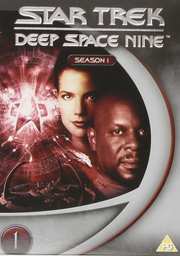
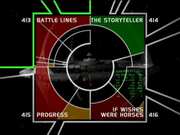
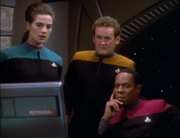

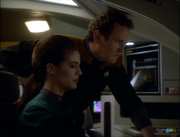


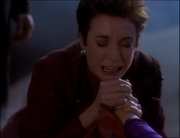
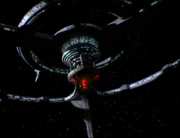

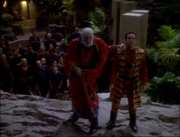
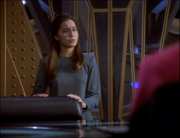
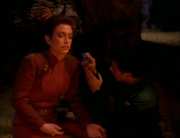
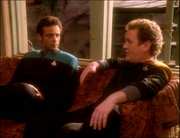
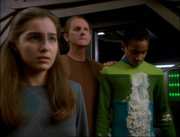

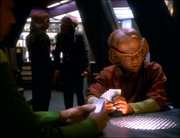

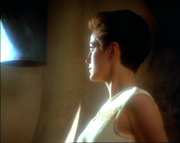
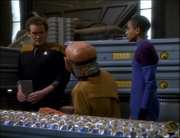
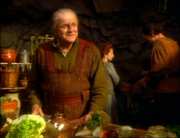

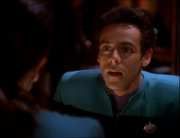

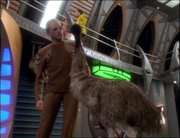
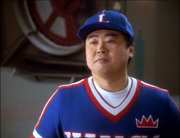
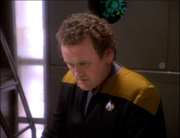
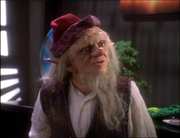

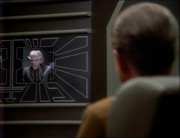
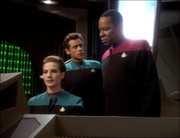


































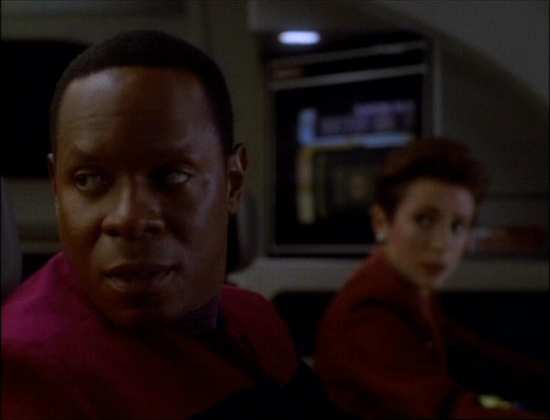
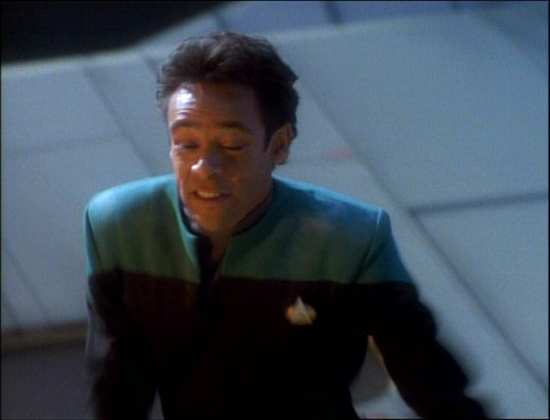














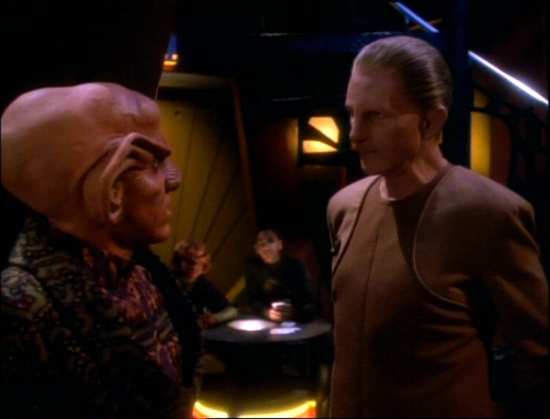

Your Opinions and Comments
Be the first to post a comment!